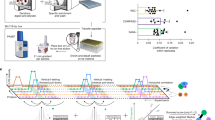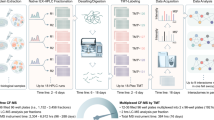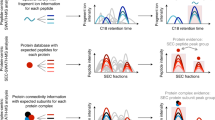Abstract
The generation of large-scale data sets is a fundamental requirement of systems biology. But despite recent advances, generation of such high-coverage data remains a major challenge. We developed a pooling-deconvolution strategy that can dramatically decrease the effort required. This strategy, pooling with imaginary tags followed by deconvolution (PI-deconvolution), allows the screening of 2n probe proteins (baits) in 2 × n pools, with n replicates for each bait. Deconvolution of baits with their binding partners (preys) can be achieved by reading the prey's profile from the 2 × n experiments. We validated this strategy for protein-protein interaction mapping using both proteome microarrays and a yeast two-hybrid array, demonstrating that PI-deconvolution can be used to identify interactions accurately with fewer experiments and better coverage. We also show that PI-deconvolution can be used to identify protein-small molecule interactions inferred from profiling the yeast deletion collection. PI-deconvolution should be applicable to a wide range of library-against-library approaches and can also be used to optimize array designs.
This is a preview of subscription content, access via your institution
Access options
Subscribe to this journal
Receive 12 print issues and online access
$259.00 per year
only $21.58 per issue
Buy this article
- Purchase on Springer Link
- Instant access to full article PDF
Prices may be subject to local taxes which are calculated during checkout




Similar content being viewed by others
References
Phizicky, E., Bastiaens, P.I., Zhu, H., Snyder, M. & Fields, S. Protein analysis on a proteomic scale. Nature 422, 208–215 (2003).
Uetz, P. et al. A comprehensive analysis of protein-protein interactions in Saccharomyces cerevisiae. Nature 403, 623–627 (2000).
Ito, T. et al. Toward a protein-protein interaction map of the budding yeast: A comprehensive system to examine two-hybrid interactions in all possible combinations between the yeast proteins. Proc. Natl. Acad. Sci. USA 97, 1143–1147 (2000).
Giot, L. et al. A protein interaction map of Drosophila melanogaster. Science 302, 1727–1736 (2003).
Li, S. et al. A map of the interactome network of the metazoan C. elegans. Science 303, 540–543 (2004).
Stelzl, U. et al. A human protein-protein interaction network: a resource for annotating the proteome. Cell 122, 957–968 (2005).
Rual, J.F. et al. Towards a proteome-scale map of the human protein-protein interaction network. Nature 437, 1173–1178 (2005).
Gavin, A.C. et al. Functional organization of the yeast proteome by systematic analysis of protein complexes. Nature 415, 141–147 (2002).
Ho, Y. et al. Systematic identification of protein complexes in Saccharomyces cerevisiae by mass spectrometry. Nature 415, 180–183 (2002).
Butland, G. et al. Interaction network containing conserved and essential protein complexes in Escherichia coli. Nature 433, 531–537 (2005).
Zhu, H. et al. Global analysis of protein activities using proteome chips. Science 293, 2101–2105 (2001).
Michaud, G.A. et al. Analyzing antibody specificity with whole proteome microarrays. Nat. Biotechnol. 21, 1509–1512 (2003).
Zhong, J., Zhang, H., Stanyon, C.A., Tromp, G. & Finley, R.L., Jr. A strategy for constructing large protein interaction maps using the yeast two-hybrid system: regulated expression arrays and two-phase mating. Genome Res. 13, 2691–2699 (2003).
Hazbun, T.R. et al. Assigning function to yeast proteins by integration of technologies. Mol. Cell 12, 1353–1365 (2003).
Wu, X., Hart, H., Cheng, C., Roach, P.J. & Tatchell, K. Characterization of Gac1p, a regulatory subunit of protein phosphatase type I involved in glycogen accumulation in Saccharomyces cerevisiae. Mol. Genet. Genomics 265, 622–635 (2001).
Winzeler, E.A. et al. Functional characterization of the S. cerevisiae genome by gene deletion and parallel analysis. Science 285, 901–906 (1999).
Giaever, G. et al. Functional profiling of the Saccharomyces cerevisiae genome. Nature 418, 387–391 (2002).
Heitman, J., Movva, N.R. & Hall, M.N. Targets for cell cycle arrest by the immunosuppressant rapamycin in yeast. Science 253, 905–909 (1991).
Carpenter, C.L. & Cantley, L.C. Phosphoinositide kinases. Biochemistry 29, 11147–11156 (1990).
Salwinski, L. et al. The Database of Interacting Proteins: 2004 update. Nucleic Acids Res. 32 (Database issue), D449–D451 (2004).
Grigoriev, A. On the number of protein-protein interactions in the yeast proteome. Nucleic Acids Res. 31, 4157–4161 (2003).
Bork, P. et al. Protein interaction networks from yeast to human. Curr. Opin. Struct. Biol. 14, 292–299 (2004).
Janda, K.D. Tagged versus untagged libraries: methods for the generation and screening of combinatorial chemical libraries. Proc. Natl. Acad. Sci. USA 91, 10779–10785 (1994).
Agyare, F.D. et al. Mapping expressed sequence tag sites on yeast artificial chromosome clones of Arabidopsis thaliana DNA. Genome Res. 7, 1–9 (1997).
Jeong, H., Mason, S.P., Barabasi, A.L. & Oltvai, Z.N. Lethality and centrality in protein networks. Nature 411, 41–42 (2001).
Jeong, H., Tombor, B., Albert, R., Oltvai, Z.N. & Barabasi, A.L. The large-scale organization of metabolic networks. Nature 407, 651–654 (2000).
Massoud, T.F. & Gambhir, S.S. Molecular imaging in living subjects: seeing fundamental biological processes in a new light. Genes Dev. 17, 545–580 (2003).
Gray, P.A. et al. Mouse brain organization revealed through direct genome-scale TF expression analysis. Science 306, 2255–2257 (2004).
Barry, J.R., Lee, E.A. & Messerschmitt, D.G. Digital communication 3rd edn. (Kluwer Academic Publishers, Boston, 2004).
Khan, A.H., Ossadtchi, A., Leahy, R.M. & Smith, D.J. Error-correcting microarray design. Genomics 81, 157–165 (2003).
Milo, R. et al. Network motifs: simple building blocks of complex networks. Science 298, 824–827 (2002).
Zewail, A. et al. Novel functions of the phosphatidylinositol metabolic pathway discovered by a chemical genomics screen with wortmannin. Proc. Natl. Acad. Sci. USA 100, 3345–3350 (2003).
Xie, M.W. et al. Insights into TOR function and rapamycin response: Chemical genomic profiling by using a high-density cell array method. Proc. Natl. Acad. Sci. USA 102, 7215–7220 (2005).
Acknowledgements
We thank H. Herschman, C. Miller, E. O'Shea, F. Fox, C. Stanyon and members of the Huang laboratory for critical readings and suggestions on the manuscript, the anonymous reviewer for introducing to us the idea of communication systems, Y. Du for assistance with drug screening and K. Scanlan for faithfully supporting our work. This research was partially supported by a Singleton Developmental Grant (to J.H.), University of California Systemwide Biotechnology Research & Education Program, Graduate Research and Education in Adaptive bioTechnology (GREAT) Training Grant 2005-268 (F.J. and J.H.), and a grant from the US National Center for Research Resources of the National Institutes of Health, P41 RR11823 (S.F.).
Author information
Authors and Affiliations
Corresponding authors
Ethics declarations
Competing interests
Some Invitrogen products (including preotein microarrays) were used druing the course of this research. G.A.M, M.S. and P.F.P. are employed by Invitrogen Life technologies.
Supplementary information
Supplementary Table 1
Design of partially overlapping pools. (XLS 16 kb)
Supplementary Table 2
Pooling scheme for Y2H array screens. (XLS 16 kb)
Supplementary Table 3
Comparison of single bait screening data and PI-Deconvolution data. (XLS 154 kb)
Supplementary Table 4
Unambiguously deconvoluted prey-bait pairs in PI-Deconvolution data. (XLS 29 kb)
Supplementary Table 5
Possible causes for profile transformation. (XLS 11 kb)
Supplementary Table 6
List of 128 yeast strains used for drug resistance PI-Deconvolution screening and generation of pools. (XLS 43 kb)
Supplementary Table 7
Proteome microarray spot data. (XLS 31 kb)
Rights and permissions
About this article
Cite this article
Jin, F., Hazbun, T., Michaud, G. et al. A pooling-deconvolution strategy for biological network elucidation. Nat Methods 3, 183–189 (2006). https://doi.org/10.1038/nmeth859
Received:
Accepted:
Published:
Issue Date:
DOI: https://doi.org/10.1038/nmeth859
This article is cited by
-
Protein kinase substrate identification on functional protein arrays
BMC Biotechnology (2008)
-
Role of mast cells in allergic and non-allergic immune responses: comparison of human and murine data
Nature Reviews Immunology (2007)
-
A yeast two-hybrid smart-pool-array system for protein-interaction mapping
Nature Methods (2007)
-
Matrix and Steiner-triple-system smart pooling assays for high-performance transcription regulatory network mapping
Nature Methods (2007)
-
Pooling in systems biology becomes smart
Nature Methods (2006)



